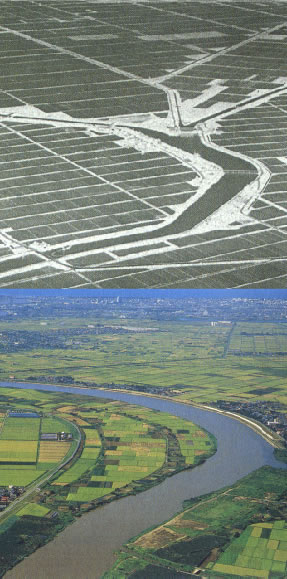

Non-paddy farming in Europe needs 1.5 hectares of agricultural land to sustain one person. By contrast, Japanese rice farming requires only 1 hectare of land to sustain 15 people; that is, the latter maintains high productivity. As approximately 70 percent of the country is covered by steep mountains Japan has very little per capita arable land compared to other countries. Thus, the spread of paddy farming was a historical inevitability.
Needless to say, paddy-farming requires huge amounts of water. The, wetlands along rivers were reclaimed and turned into farmland. People built canals or diversion weirs to draw water from rivers into their fields.
However, this meant that each time a flood came, the swollen water in the river would quickly spill over channels as to flood the fields. On the other hand, the construction of high dikes to hold back flood water would check water intake from river during drought.
In addition, Japan is subject to the unmanageable Asian monsoon, which brings heavy rainfall during the early-summer rainy season as well as dry spells lasting even one month long.
While floods brought people to a hell on earth, the droughts were also a time of bloody massacre.
If villages upstream drew sufficient water from a river, the downstream would dry up with little water left. If people on the left bank took much water in, the right bank would not hesitate to protest. Disputes over water rights involved villages both upstream and downstream, on the right and the left of rivers, bringing about confusion, negotiation, reconciliation and the use of force in the worst case, resulting in brutal conflicts with lives being lost.
“One drop of water in Shibumi River is one drop of blood.”
This is the traditional saying that was passed down among the farmers of Nagaoka in Niigata prefecture.